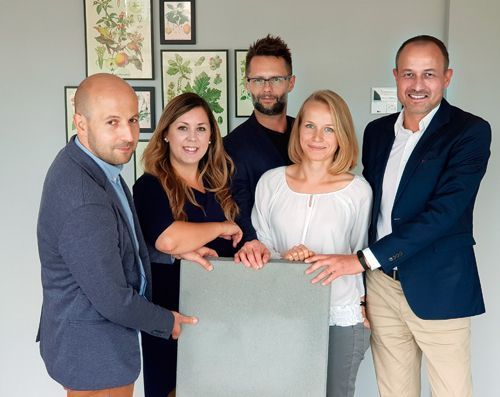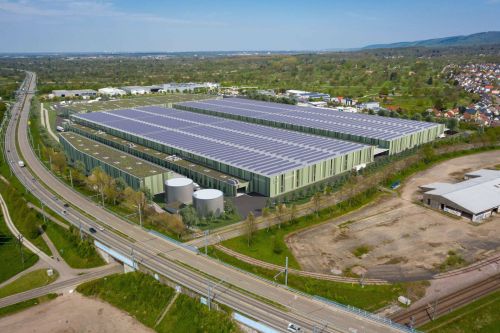A concrete solution to smog
Innovations by Skanska
The air quality indexes in Warsaw and the largest Polish cities all confirm that the concentration of harmful substances in the air in these locations exceeds acceptable standards. Most of these cities are attempting to deal with this phenomenon by introducing restrictions on vehicular traffic (e.g. paid parking zones and even prohibiting entry to the city centre), improving public transport and promoting cycling. In the real estate sector, the environmental trend, as exemplified by the growing popularity of green certificates, has encouraged developers to use materials and systems that help to reduce the negative impact of their activities on the natural environment. But it turns out that you can go even further – buildings can actually improve the nature around them.
A really green idea
At the Rondo Daszyńskiego roundabout in Warsaw, Skanska is developing the Generation Park office complex, which the company hopes will become a new green point on the Warsaw map – and not only for the people who will work there. A large section of the paving between the buildings will be laid with stones made out of air-purifying TX Active concrete. “This is the first commercial project to use this technology in Central Europe. We are introducing it in cooperation with the Polish Academy of Sciences, the Warsaw University of Technology and the University of Warsaw,” reveals Skanska’s innovation manager Anna Tryfon-Bojarska, with some pride. “These paving stones are now being produced in Poland specially to our company’s order. The shape and colour of the material conforms with the architectural design of Generation Park. It is a binding material produced by using titanium oxide imported from Italy, which has neutralising properties,” she adds.
Titanium oxide is hardly a novel substance – it has been added to paints for years and is also used in the textile, food, pharmaceutical and cosmetics industries – but it has only recently made its debut as a photocatalytic (i.e. activated by UV radiation) added to concrete. After being milled to a nanometric fraction (a single particle has a diameter of 1 to 100 nanometres), the oxide is added to the binding material used for the production of concrete elements, including paving stones. Such ‘smart’ binding material is currently produced in two factories in Europe as well as in the US and Japan. “Where did we get the idea of using air-purifying concrete in our projects? It fits in with one of the planks of Skanska’s philosophy – to establish cooperative relationships with other entities in the sector that think along green lines,” explains Hubert Witkowski, Skanska’s R&I coordinator. “This cooperation is carried out under the open innovation format – according to which we seek out ways of connecting the different industries and competences of our partners with our own. In this way we have established cooperation with Górażdże of the Heidelberg Group, whose laboratory in Italy has developed a concrete that can neutralise pollutants in the air,” he emphasises.
Jack of all trades
The air purification process of photocatalytic concrete is triggered by solar radiation and as such does not require any additional input. All that’s needed is to ensure that it is always exposed to natural light (e.g. by removing any snow or sand from them). It is also important that the concrete ‘self-cleans’ throughout its useful life so that the catalyst can be as effective as possible as it is being used up. “Of course, the pollutants removed from the air do not miraculously disappear. As the surface of the concrete reacts, the air pollutants are turned into soluble salts that are then dissipated into the ground by the rain. This substance is similar to the kind of fertiliser for flowers you can buy in gardening stores,” explains Krzysztof Szerszeń, a geotechnical products research and development coordinator at Górażdże. “The photocatalytic properties of concrete can reduce the concentration of many harmful substances, such as nitrogen oxides, sulphur oxides, carbon monoxide and volatile organic compounds such as benzene, toluene and formaldehyde. They retain their unique properties throughout the lifetime of the concrete and only ultra-violet rays are needed to trigger this effect. These materials also have a number of other beneficial properties, including antibacterial properties and protecting concrete elements from the growth of fungi and mould,” he adds.
One milestone in the development of photocatalytic concrete was the construction of the Millennium Church in Rome. When designing the characteristic three-sail shape of the building, globally-renowned architect and Pritzker Prize winner Richard Meier was looking for a way of preserving the façade’s white colour (ordinary white concrete loses its original colour over time). The researchers suggested adding nanometric titanium oxide to the concrete, which did in fact keep the façade unchanged for many years. “The effectiveness of air purification by TX Active photocatalytic concrete depends on many factors. A standard test is used to determine its efficacy, involving placing a concrete product inside a closed chamber where it is exposed to contaminated air and UV radiation. The lowest level of pollution neutralised should be 12 pct,” explains Krzysztof Szerszeń.
“We were able to see the effectiveness of this material in early June, when we put a paving stone produced using this technology and covered with a nanometre layer of titanium oxide under a scanning microscope,” reveals Anna Tryfon-Bojarska.
A really healthy pitch
“Photocatalytic concrete seems ideal for such places as foot and cycle paths, recreational areas, playgrounds and areas around sports fields, particularly where the air quality from vehicular traffic is a serious issue,” claims Krzysztof Szerszeń of Górażdże.
Generation Park in Warsaw should have a beneficial effect in all these areas – for the office complex’s staff and visitors to the shopping arcade between the buildings, as well as the children of the nearby school and cyclists who use the bike paths in the neighbourhood. At the end of June, at the time of the writing of this article, the finishing work was already underway on the test section between the buildings of Generation Park. When the paving stones are laid, measuring stations will be installed nearby to gauge the actual effectiveness of the concrete. If it passes the test, the public square planned for the complex will be paved with the ‘smog-eating’ stones. This will have an area similar to that of a football pitch – and so would be able to neutralise pollutants equivalent to those that had been produced by a diesel engine car with around 140,000 km on the clock.

“Photocatalytic concrete seems ideal for such places as foot and cycle paths, recreational areas, playgrounds and areas around sports fields, particularly where the air quality from vehicular traffic is a serious issue,” claims Krzysztof Szerszeń of Górażdże
“We decided to use paving stones made out of photocatalytic concrete in Generation Park, because it is located at the junction of two of Warsaw’s main arteries – ul. Towarowa and ul. Prosta – where the conditions are ideal for testing out the effectiveness of this approach. On the other hand, pavements seem to be the best place to test this material from the perspective of construction. We have not ruled out using it in our future projects and in other ways too, such as on façades or in structural elements, provided that the measurements confirm the effectiveness of ‘green concrete’,” adds Adam Targowski, the sustainable development manager of Skanska Commercial Development Europe.






















































